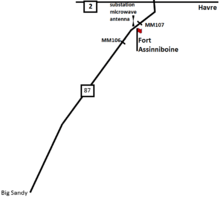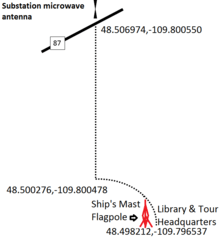Fort Assinniboine
| Fort Assinniboine | |
|---|---|
| Hill County, six miles southwest of Havre, Montana | |
|
Company Officers' Quarters at Fort Assinniboine | |
| Site information | |
| Controlled by | United States |
| Site history | |
| Built | 1879 |
| In use | 1879-1911 |
| Battles/wars |
Cree Campaign |
|
Fort Assinniboine | |
  | |
| Nearest city | Havre, Montana |
| Coordinates | 48°29′59″N 109°47′39″W / 48.49972°N 109.79417°WCoordinates: 48°29′59″N 109°47′39″W / 48.49972°N 109.79417°W |
| Area | 160 acres (65 ha) |
| Built | 1879 |
| Architect | Lee,Col. J.G.C.; Devlin,L.K. |
| NRHP Reference # | [3] |
| Added to NRHP | May 31, 1989 |
Fort Assinniboine, was a United States Army fort located in present day Montana (historically within the military Department of Dakota), built in 1879 and in operation through 1911.
Context
Following the Great Sioux War of 1876-77 and the disastrous defeat of U.S. Army forces led by General Custer at the Battle of Little Big Horn on June 25, 1876, and the defeat and capture of the Nez Perce, band of Chief Joseph by the U.S. Army in the Battle of Bear Paw in 1877, General Phil Sheridan suggested that a fort be built on or near the Milk River to ward off possible attacks from the North by the Sioux led by Chief Sitting Bull, who had migrated to the Cypress Hills in Canada, or by the Nez Perce, some of whom were also in Canada. Lt. Col. J.R. Brooke recommended the site where the post was established. The fort is located in Hill County six miles southwest of Havre (the county seat) on Highway 87. It was named for the Siouan-speaking Assinniboine people. The Native Americans never attacked from Canada.
Active period
The fort was located on a massive military reservation stretching south to the Missouri River, north to the Milk River and containing the Bear Paw Mountains. It encompassed 704,000 acres (1,100 sq. mi., 2850 km2) at its maximum extent in 1880. It later receded to encompass only 220,000 acres (344 sq. mi., 890 km2). At its peak, it garrisoned more than 750 officers and enlisted men and their families. With 104 buildings, the fort was one of the largest ever built in the United States.
Fort Assinniboine's 10th Cavalry Buffalo Soldiers supported the flank of Roosevelt's "Rough Riders" at San Juan Hill. Eyewitnesses noted that, the Rough Riders would not have prevailed without them.
Notable people
Among the military officers stationed at the fort John Pershing is the most notable. Pershing so impressed General-in-chief of the Army Maj. General Nelson A. Miles, on a hunting trip in the area, that Miles transferred him to Washington, D.C. as an aide-de-camp. Pershing later served as a tactical officer at West Point. When the Spanish–American War broke out in 1898, he was reassigned, upon his request, back with the famed Buffalo Soldiers of Fort Assinniboine from the 10th Cavalry. They fought alongside Roosevelt in Cuba at the Battle of San Juan Hill. Pershing later achieved worldwide fame as the leader of the American Expeditionary Force in World War I, but he distinguished himself regularly over the course of his career.
Though less well known, but perhaps no less impressive was Sgt. Horace Bivens.
Closure
By the early twentieth century, hundreds of Chippewa Cree people lived on the large military reservation. They traded with the Army and had no land of their own. In 1916, the government ceded a portion of Fort Assinniboine to the Rocky Boy Indian Reservation, established for the Chippewa Cree tribe.
A picturesque portion of the reserve, where the beaver creek ran through the Bear Paws Mountains, was first designated a national park, then ceded to the city of Havre with the purpose of becoming a city recreation area, and eventually transferred to Hill County creating Beaver Creek Park, the largest county park in the United States.
Most of the buildings at the Fort were razed and hauled away for building materials; a handful of surviving structures have been adapted for use as both an agricultural research station associated with Montana State University, and a historical preservation site.
Tourism
It is possible to visit what remains of Fort Assinniboine. The Havre Chamber of Commerce, and the Hill County Museum both furnish current visitor information. As of this writing a tour guide is available during the summer season (June 1 through September 1), Monday through Friday 9AM to 5PM, Saturday and Sunday at noon and 5PM. Tours can also be arranged by appointment.
| HWY 87 Overview | Local Dirt Roads |
|---|---|
 |
 |
See also
References
- ↑ National Park Service (2009-03-13). "National Register Information System". National Register of Historic Places. National Park Service.
- ↑ Grit, Guts & Gusto: A History of Hill County, January 1, 1976, Hill County Bicentennial Committee (Author)
- ↑ Montana State University Library, Collection 2457 - Fort Assinniboine Telegrams Received, 1881
External links
- Old Forts Trail entry
- Official Montana state travel site
- MHS Historic Sign Texts
- Guide to the Fort Assiniboine Records 1879-1906
- Fort's Official Homepage (maintained by Havre Chamber of Commerce)